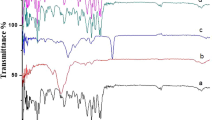Abstract
The aim of this study was to evaluate and compare the in vitro and in vivo transdermal potential of w/o microemulsion (M) and gel (G) bases for diclofenac sodium (DS). The effect of dimethyl sulfoxide (DMSO) as a penetration enhancer was also examined when it was added to the M formulation. To study the in vitro potential of these formulations, permeation studies were performed with Franz diffusion cells using excised dorsal rat skin. To investigate their in vivo performance, a carrageenan-induced rat paw edema model was used. The commercial formulation of DS (C) was used as a reference formulation. The results of the in vitro permeation studies and the paw edema tests were analyzed by repeated-measures analysis of variance. The in vitro permeation studies found that M was superior to G and C and that adding DMSO to M increased the permeation rate. The permeability coefficients (Kp) of DS from M and M+DMSO were higher (Kp=4.9×10−3±3.6×10−4 cm/h and 5.3×10−3±1.2×10−3 cm/h, respectively) than the Kp of DS from C (Kp=2.7×10−3±7.3×10−4 cm/h) and G (Kp=4.5×10−3±4.5×10−5 cm/h). In the paw edema test, M showed the best permeation and effectiveness, and M+DMSO had nearly the same effect as M. The in vitro and in vivo studies showed that M could be a new, alternative dosage form for effective therapy.
Similar content being viewed by others
References
Barry BW. Novel mechanisms and devices to enable successful transdermal drug delivery. Eur J Pharm Sci. 2001;14:101–114.
Moser K, Kriwet K, Naik A, Kalia YN, Guy RH. Passive skin penetration enhancement and its quantification in vitro. Eur J Pharm Biopharm. 2001;52:103–112.
Nishihata T, Kamada A, Sakai K, et al. Percutaneous absorption of diclofenac in rats and humans: aqueous gel formulation. Int J Pharm. 1988;46:1–7.
Parsaee S, Sarbolouki MN, Parnianpour M. In vitro release of diclofenac diethylammonium from lipid-based formulations. Int J Pharm. 2002;241:185–190.
Ho HO, Huang FC, Sokolaski TD, Sheu MT. The influence of cosolvents on the in-vitro percutaneous penetration of diclofenac sodium from a gel system. J Pharm Pharmacol. 1994;46:636–642.
Iwasa A, Irimoto K, Kasai S, Okuyama H, Nagai H. Effect of nonionic surfactants on percutaneous absorption of diclofenac sodium. Yakuzaigaku. 1991;51:16–21.
Santoyo S, Arellano A, Ygartua P, Martin C. Penetration enhancer effects on the in vitro percutaneous absorption of piroxicam through rat skin. Int J Pharm. 1995;117:219–224.
Nair VB, Panchagnula R. The effect of pretreatment with terpenes on transdermal iontophoretic delivery of arginine vasopressin. Farmaco. 2004;59:575–581.
Tokudome Y, Sugibayashi K. The synergic effects of various electrolytes and electroporation on the in vitro skin permeation of calcein. J Control Release. 2003;92:93–101.
Al-Saidan SM, Krishnaiah YSR, Chandrasekhar DV, et al. Formulation of an HPMC gel drug reservoir system with ethanol-water as a solvent system and limonene as a penetration enhanceer for enhancing in vitro transdermal delivery of nicorandil. Skin Pharmacol Physiol. 2004;17:310–320.
Paul BK, Moulik SP. Microemulsions: an overview. J Disper Sci Technol. 1997;18:301–306.
Prince LM. Microemulsions. In: Lissant KJ, ed. Emulsions and Emulsion Technology. New York, NY: Marcel Dekker; 1974:125–178.
Delgado-Charro MB, Iglesias-Vilas G, Blanco-Mendez J, Lopez-Quintela MA, Marty JP, Guy RH. Delivery of a hydrophilic solute through the skin from novel microemulsion systems. Eur J Pharm Biopharm. 1997;43:37–42.
Celebi N, Kislal O, Tarimci N. The effect of β-cyclodextrin and penetration additives on the release of naprosen from ointment bases. Pharmazie. 1993;48:914–917.
Gupta P, Vermani K, Garg S. Hydrogels from controlled release to pH-responsive drug delivery. Drug Discov Today. 2002;7:569–579.
Dureja H, Tiwary AK, Gupta S. Simulation of skin permeability in chitosan membranes. Int J Pharm. 2001;213:193–198.
El Laithy HM, El-Shaboury KM. The development of Cutina lipogels and gel microemulsion for topical administration of fluconazole. AAPS PharmSciTech. 2002;3:E35.
Obata Y, Takayama K, Maitani Y, Machida Y, Nagai T. Effect of ethanol on skin permeation of nonionized and ionized diclofenac. Int J Pharm. 1993;89:191–198.
Kantarci G, Özgüney I, Karasulu HY, Güneri T, Başdemir G. In vitro permeation of diclofenac sodium from novel microemulsion formulations through rabbit skin. Drug Dev Res. 2005;65:17–25.
Cordero JA, Alarcon L, Escribano E, Obach R, Domenech J. A comparative study of the transdermal penetration of a series of nonsteroidal antiinflammatory drugs. J Pharm Sci. 1997;86: 503–508.
Winter CA, Risley EA, Nuss GV. Carrageenan-induced edema in hind paw of the rat as an assay for anti-inflammatory drugs. Proc Soc Exp Biol Med. 1962;111:544–547.
Escribano E, Calpena AC, Queralt J, Obach R, Doménech J. Assessment of diclofenac permeation with different formulations: anti-inflammatory study of a selected formula. Eur J Pharm Sci. 2003;19:203–210.
Park KM, Kim CH. Preparation and evaluation of flurbiprofenloaded microemulsion for parenteral delivery. Int J Pharm. 1999;181:173–179.
Adayeye CM, Li PK. Diclofenac sodium. In: Florey K, ed. Analytical Profiles of Drug Substances. New York: Academic Press; 1990:123–144.
Ferreira LAM, Seiller M, Grossiord JL, Marty JP, Wepierre J. Vehicle influence on in vitro release of glucose: w/o, w/o/w and o/w systems compared. J Control Release. 1995;33:349–356.
Panigrahi L, Pattnaik S, Ghosal SK. The effect of pH and organic ester penetration enhancers on skin permeation kinetics of terbutaline sulfate from pseudolatex-type transdermal delivery system through mouse and human cadaver skins. AAPS PharmSciTech. 2005;6:E167-E173.
Lawrence MJ, Rees GD. Microemulsion-based media as novel drug delivery systems. Adv Drug Deliv Rev. 2000;45:89–121.
Anigbogu ANC, Williams AC, Barry BW, Edwards HGM. Fourier transform raman spectroscopy of interactions between the penetration enhancer dimethyl sulfoxide and human stratum corneum. Int J Pharm. 1995;125:265–282.
Kreilgaard M. Influence of microemulsions on cutaneous drug delivery. Adv Drug Deliv Rev. 2002;54:S77-S98.
Kreilgaard M, Pedersen EJ, Jaroszewski JW. NMR characterisation and transdermal drug delivery potential of microemulsion systems. J Control Release. 2000;69:421–433.
Mei Z, Chen H, Weng T, Yang Y, Yang X. Solid lipid nanoparticle and microemulsion for topical delivery of triptolide. Eur J Pharm Sci. 2003;56:189–196.
Author information
Authors and Affiliations
Corresponding author
Additional information
Published: October 20, 2006
Rights and permissions
About this article
Cite this article
Özgüney, I.S., Karasulu, H.Y., Kantarci, G. et al. Transdermal delivery of diclofenac sodium through rat skin from various formulations. AAPS PharmSciTech 7, 88 (2006). https://doi.org/10.1208/pt070488
Received:
Accepted:
Published:
DOI: https://doi.org/10.1208/pt070488




